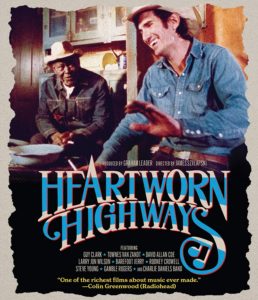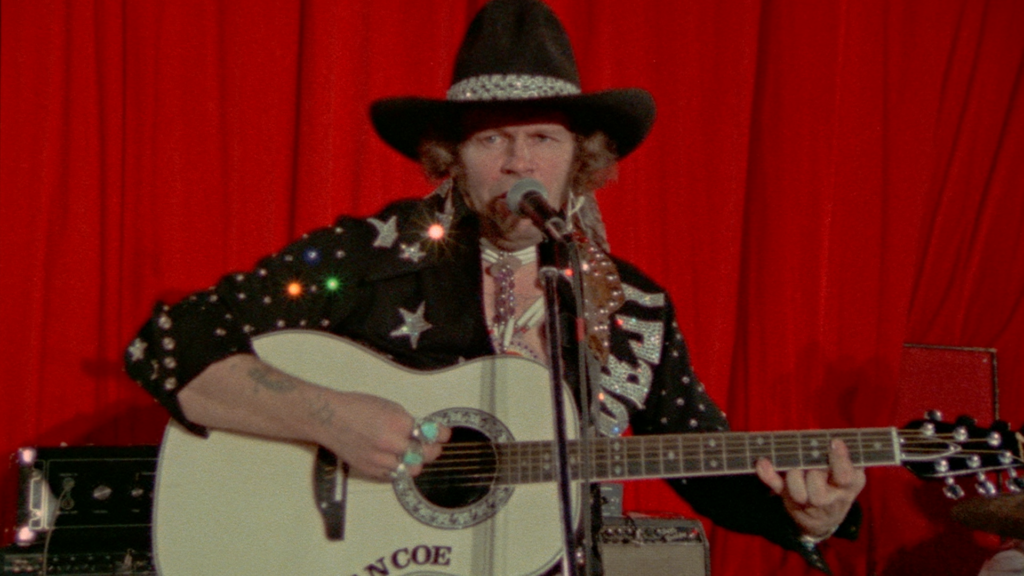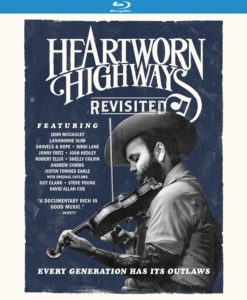Outlaw Country Gets its Blu Due.
BLU-RAY RELEASE DATE: APRIL 27, 2021/KINO CLASSICS & KINO LORBER
Sending me down more Spotify rabbit holes than I care to count are the two Heartworn Highways films. The first one, from the early phase of what some think of as “third generation country music”, aka “Outlaw Country”, has managed to muster up a lofty little reputation for itself while kickin’ around in relative obscurity for decades.
The second, from only five or so years ago (I’ve seen three different release years; let’s go with what Kino Lorber’s website says), documents a considerably more recent but equally compelling gaggle of such musicians.
The commonality? These guitar pickers are unkempt and surly; their hats are banged up and smashed, their coats look old, and their shirts are probably missing the sleeves. Cigarettes and hard liquor fuel these folks, not gold records and Music Row schmoozing. They are of a separate Nashville, a scene more dive-bar than The Grand Ole Opry. At the beginning of the second film, Bobby Bare, Jr. explains that if Kris Kristofferson were getting started now, he’d be one of them, forever blowing from gig to gig like some kind of beat-up tumbleweed. He’d never find his Johnny Cash, the one who’d champion him and record one of his songs. Toby Keith and Kenny Chesney don’t hand out breaks like that. They probably think they do, but they don’t.
Anyhow, these are two terrific music docs that you need to know about. Here’s a breakdown of each of these newly released discs:
Heartworn Highways
DIRECTED BY JAMES SZALAPSKI/1976 (Theatrical Release 1981)

Lurking deep in the gutter of the pantheon of great music documentaries, one finds 1976’s Heartworn Highways. The film is a rough n’ tumble look into the “Outlaw Country” music movement just as it was beginning to gain momentum. You can be forgiven for any unfamiliarity; the film struggled for release back in its day and didn’t in fact find distribution until 1981. Then it went missing again for decades, passed around by fans on weathered VHS tapes.
Heartworn Highways isn’t like a lot of the other music docs. First-time (and only-time) director James Szalapski heavily commits to the Pennebaker or Maysles approach, operating as a fly on the wall. No narrator, no formal talking-head interviews, no on-screen identifiers along the way. You’d better have paid close attention to the opening sequence that pairs still photos with the featured individuals, because that’s all the help you get in confirming who’s who.
That who’s who includes but is not limited to musicians and fellow colorful characters Guy Clark, Townes Van Zandt, Steve Earle, David Allan Coe, Rodney Crowell, and The Charlie Daniels Band (jamming to one amazing adrenalized rapid-fire montage of small-town cars, storefronts, and everyday life). For then-young Earle and Crowell, Heartworn Highways is said to be the very first known recordings of them performing. See! Peggy Brooks singing her heart out in a dive bar. Watch! The road-mapped face of Larry Jon Wilson recording bleary-eyed in a studio made of raw tree bark. Witness! Townes Van Zandt tumble down a hole, never to be seen again.
Handheld and a-wanderin’, Szalapski’s camera is as restless as the scene itself. Growing pains and fits-and-starts are what this is all about. It’s not a concert, it’s not a behind-the-scenes, it’s not even an official chronicle. Yet, Heartworn Highways is, at times, all of those things. It’s about the way the light reflects off the shiny guitar neck of a silver-sequined David Allan Coe as he plays to inmates at the Tennessee State Prison. It’s about Coe regaling that crowd about his time there, doing time. It’s also about him driving his own tour bus across the country to get to that gig, working the C.B. radio the whole way to make the best time. In short, it’s a lot about a very specific moment, if numerous places. Coe is just one of many featured players, though his trek and subsequent show are as close to a through-line as Szalapski gets.
But really, underneath and alongside of all the rustic, unkempt decor, the near-constant whiskey drinking (complete with a mid-film bottling montage ode to Jack Daniels set to “Black Label Blues” by Gamble Rogers, following a hilariously verbose monologue intro), and custom guitar modification tutorials, Heartworn Highwaysis about the palpable tear shed by aging African American blacksmith of direct slavery descent as he sits in an unkempt kitchen listening to Townes Van Zandt pluck out a makeshift rendition of “Waiting Around to Die”.

The hard-drinkin’ and hard-playin’ musicians of Heartworn Highways went on to forge a vital and (some would say) course-correcting trail for the future of American country music. While imperfect in many behavioral ways (the racism often associated with Outlaw Country music of the era is mostly if not completely absent from this film), the movement was similarly born of other, broader smokes & moonshine imperfections. The attitude is, America itself is imperfect, dammit- but it’s what we’ve got. In a moment when (as one old guy tells the camera) “Johnny Cash has shot his wad” (with his glossy TV show and whatnot), the boisterous, calloused everyman gut-wallop of singers like Steve Young, Gamble Rogers, Guy Clark, and the others have proven deeply resonant in the fabric and soul of the country’s ongoing reckoning with itself.
Kino’s Blu-ray edition features an audio commentary track with producer Graham Leader and editor/assistant director Phillip Schopper. The track seems to be a carry-over from a previous DVD release, as they refer to the film finally becoming available on that format and such. Lots of good trips little down their memory lanes of making the movie, and remembrances of late director Szalapski, who died in 2000, which seems to around the time of this commentary.
There’s also over an hour of bonus footage, mostly more terrific performances. Some are impromptu living room jams, such as Townes Van Zandt playing “the medley of his hit” “Pancho and Lefty”; others are stage outtakes such as The Charlie Daniels Band doing “Long Haired Country Boy”. And then there’s Coe cutting loose during the prison show with a few Black gospel singers backing him up on some sort of freeform whackadoodle something-or-other, the likes of which remains unclassifiable. A lot of the performers in this bonus reel don’t feature in the movie proper, which means they didn’t get identified in the opening titles, which means, I must admit, I don’t know who they are. But by gum, they sure sound good doing what they’re doing here.
Heartworn Highways Revisited
DIRECTED BY WAYNE PRICE/2017


However many decades on, with the original director long dead, Heartworn Highways has been revisited. Not just revisited, but successfully followed up. Director Wayne Price’s Heartworn Highways Revisited isn’t so much a tribute to James Szalapski’s original Outlaw Country music documentary, but a continuation. At the risk of inciting accusations of sacrilege, it’s just as good as the first one.
Without the 20/20 hindsight that we can now apply to the 1976 film, it’s impossible to know if Price’s new crop of contemporary “Outlaw” musicians will forge anything resembling the immortal legacies of then-lesser-known singer-songwriters Guy Clark, Steve Young, and David Allan Coe. (All three of whom appear in Revisited, the former two getting in just under death’s wire).
Featured not dissimilarly to how Szalapski separately organized his ramshackle grouping are musicians John McCauley, Jonny Fritz, Josh Hedley, Justin Townes Earle, husband and wife duo Shovels & Rope, Langhorne Slim, Robert Ellis, Andrew Combs, Shelly Colvin, Phil Hummer, and others. Like the old guys before them, it’s not uncommon to see a girlfriend or wife sitting next to them staring into space bored as all heck while the would-be icon pours out his entire soul in a single song. Like the original wave in their time, all are fresh faced and high on music (among other things). A difference might be that these fellas have longer beards and more tattoos.
Another difference is that this film feels very plugged into the contemporary world in a way that Szalapski’s film did not. Heartworn Highways, even then, one suspects, plays like a guitar-scored random amble thorough a different area altogether. Revisited addresses that cutthroat Nashville scene right out of gate before heading off in only slightly farther and wider directions. The very first musician that is named dropped in the movie is Lady Gaga. It’s a throwaway reference to having been “born this way”, and one that the commenter seems immediately embarrassed about. But still, such an instant reference to “the outside world” remains kinda unthinkable in the context of the original film. It’s not good or bad per se, just a small, quick indicator right out of the of how things have changed.
Sometimes called folk, sometimes called Americana, one thing is certain: These acts are as hard to classify as they are compelling. Along the way, we’re divulged the elusive difference between “Country” and “Americana”: Americana shows have the same songs, just no Republicans.

Being a much newer film, Revisited looks considerably more crisp and clean. It does not, however, appear cheap or shoddy. Director Price has a candidly upbeat commentary on the disc, as well as about twenty-seven minutes of outtakes that you can take or leave.
Price, a self-proclaimed “kid from New York” with no personal connection to the scene he’s covering, does an outstanding job of cultivating the same kind of curiously immersive aesthetic of Heartworn Highways. Without an official tally to lean on, it feels as though Revisited actually has more music in it.
Of course, with the presence of a surly ol’ Guy Clark (sporting a nasty eye bruise in many scenes) in what turned out to be a twilight appearance for him, the one song that rightfully unites the two films across their many decades is his classic that started it all, “L.A. Freeway”. With its refrain evoking both mischievous wordplay, weary life on the run, and straight-up exhaustion, the song remains the very embodiment of “heartworn”. I defy anyone to come away from these two excellent films without these lyrics rattling about in their head: “If I could just get off of this L.A. freeway without gettin’ killed or caught…”


